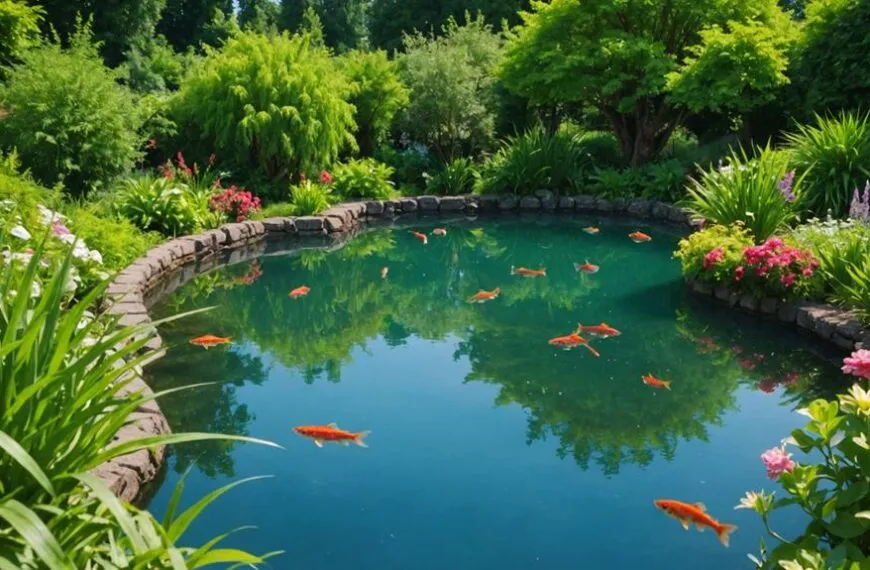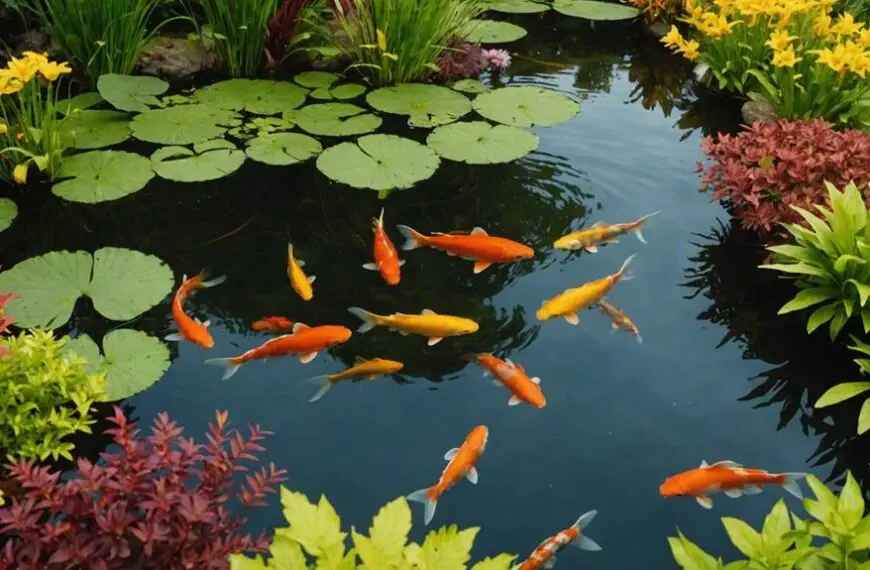Keeping your fish cool in the scorching summer isn't just a nice idea; it's essential for their well-being! Start by maintaining a steady temperature around 79°F and watch for signs of heat stress, like rapid gill movement or lethargy. You can relocate your tank to a shaded area or even air-conditioned room. Use fans for evaporative cooling – aiming them across the water surface helps! Consider investing in a chiller for precise control. Regular partial water changes, even using cooler water, can cool them down too. Stick around and you'll discover more helpful tips to keep your aquatic pals comfortable!
Contents
- 1 Understanding Ideal Temperature Ranges
- 2 Signs of Heat Stress in Fish
- 3 Effective Heat Source Removal
- 4 Benefits of Relocating Aquariums
- 5 Techniques for Evaporative Cooling
- 6 Insulation Strategies for Fish Tanks
- 7 Advantages of Using a Chiller
- 8 Water Change Best Practices
- 9 Monitoring Temperature Consistently
- 10 Additional Cooling Tips and Resources
- 11 Frequently Asked Questions
- 12 Final Thoughts
Understanding Ideal Temperature Ranges
Understanding ideal temperature ranges is crucial for maintaining a healthy aquarium environment. You want your fish to thrive, and that means keeping a close eye on water temperature.
Tropical fish, like discus and clown loaches, love it warm, usually between 74°F and the mid-80s°F. On the other hand, those common goldfish are more comfortable in cooler waters, around 60°F to 70°F.
When temperatures rise too quickly, it puts your fish in a tough spot. Rapidly increasing heat boosts their metabolism, requiring more dissolved oxygen to stay healthy. However, warmer water can't hold as much oxygen, which is like asking a fish to run a marathon without enough air!
As fish experience elevated metabolic rates, their oxygen demand increases, making it vital to monitor water conditions closely for dissolved oxygen levels.
Sudden temperature shifts can throw off your fish's biological functions, causing stress that might lead to illness or, in the worst case, mortality. Keeping a consistent ambient temperature around 79°F (26°C) usually helps keep your fish tanks cozy and within those ideal temperature ranges.
Signs of Heat Stress in Fish
Recognizing signs of heat stress in fish is essential for maintaining a healthy aquarium. When water temperatures rise, fish can struggle to get enough oxygen. You might notice rapid gill movement or gasping at the surface, which is a clear indication that your fish are feeling the heat.
If your aquatic friends seem lethargic, swim erratically, or hide more than usual, they may be overwhelmed by the warm water. It's important to regularly monitor water quality parameters to ensure your fish remain healthy during the summer months.
Another sign you shouldn't ignore is cloudy water caused by increased algae growth. This can indicate stress and poor tank health due to high temperatures. Remember, when fish are dealing with heat stress, their immune systems might falter, making them more prone to illness.
Additionally, keep an eye on your water parameters. High temperatures can lead to toxic ammonia and nitrite spikes, especially if your filtration isn't up to par. Staying vigilant about these signs can help you act quickly.
Effective Heat Source Removal
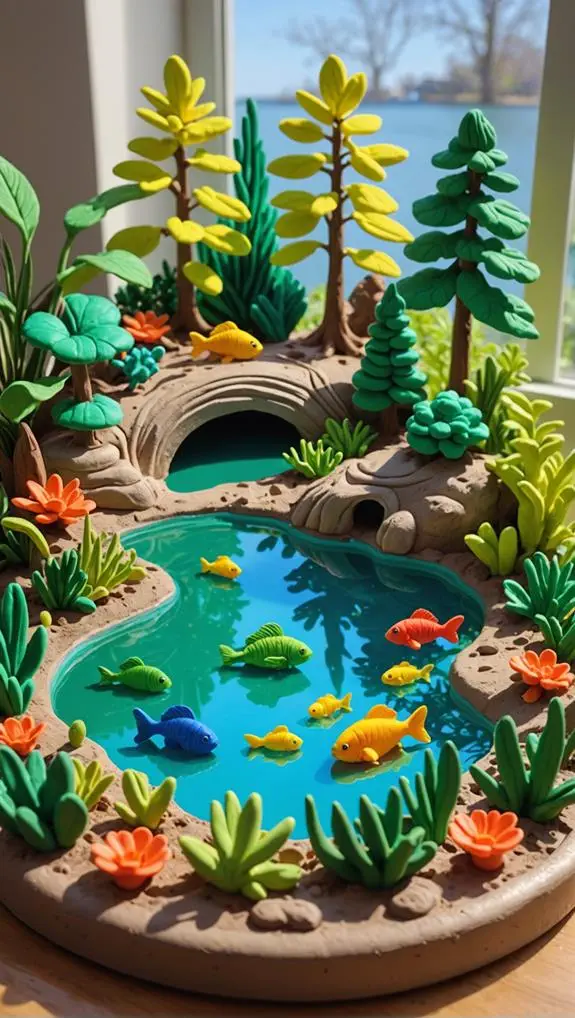
When summer rolls around and the temperature rises, it's time to lighten the load on your aquarium. You can start by disconnecting any unnecessary equipment like heaters and skimmers that only add heat.
Additionally, ensuring that your filtration system is efficient can also help in reducing heat buildup, as a good filtration system is essential for maintaining a healthy aquatic environment.
Switching to energy-efficient LED lights and using a sponge filter can make a huge difference, keeping your fish cool and happy while saving you some electricity too!
Disconnect Unnecessary Equipment
Summer heat can pose a serious threat to your aquarium's inhabitants, making it crucial to manage the temperature effectively.
One of the best ways to combat heat accumulation is to disconnect unnecessary equipment. By temporarily removing items that generate heat, you can create a more comfortable environment for your fish.
Here are some key steps to help you control tank temperature:
- Unplug heaters, UV sterilizers, and skimmers when they're not needed.
- Switch to a sponge filter with an air pump, which produces less heat than traditional canister filters.
- Regularly check your equipment for any high-heat devices and replace them with cooler alternatives.
Upgrade to LED Lighting
Disconnecting unnecessary equipment is just one step in managing the heat in your aquarium.
Another great move is to upgrade to LED lighting. These lights are fantastic because they significantly reduce heat output compared to traditional bulbs. You'll notice that LEDs generate much less heat, which is a blessing during those sizzling summer months when your fish could use a break.
By making this switch, you can lower water temperatures by several degrees, creating a more comfortable environment for your aquatic friends. Plus, LED lights operate at lower wattages, which means you'll see a decrease in energy consumption. It's kind of like giving your tank a cool drink of water!
Many LED systems even come with efficient cooling mechanisms, so you can enjoy optimal performance without cranking up the heat in your tank.
If you're feeling fancy, consider using programmable LEDs to simulate natural light cycles while keeping heat levels in check. Not only will your fish thank you, but you'll also feel good knowing you're providing a better habitat for them.
Use Efficient Filtration
Efficient filtration is essential for maintaining a stable and comfortable environment for your fish, especially during warmer months. By using the right filtration system, you can help manage temperature changes in your aquarium and keep the water cooler.
Here are some tips to get you started:
- Opt for a sponge filter with an air pump to minimize heat in the water.
- Regularly check and clean your filter to prevent inefficiencies that can raise water temperatures.
- Choose a filter that fits your tank size to ensure proper water circulation and oxygenation.
When your filtration system runs smoothly, it not only removes toxins but also supports cooler water. It's important to monitor your water surface and make sure the flow is steady.
A well-functioning filter can help dissipate heat, making it easier for your fish to thrive. Remember, a happy fish is a healthy fish!
Benefits of Relocating Aquariums
Relocating your aquarium can be a game changer for maintaining optimal conditions for your fish. If you've been struggling with rising water temperatures, consider moving your tank away from direct sunlight. Even a little sun can crank up the heat by several degrees, putting your fish in a tough spot.
An air-conditioned room is a great choice for relocating aquariums. It helps keep the water cool and stable, especially during those sweltering summer days. Plus, positioning your aquarium away from heating vents and exterior doors will help minimize unwanted heat from sneaking in.
Think about placing your tank in shaded areas or even a basement, where the ambient temperature is typically cooler year-round. Not only will this reduce the impact of seasonal heat, but it can also enhance air circulation.
Your fish will thank you for the extra comfort, and you'll find it easier to maintain a healthy environment.
Techniques for Evaporative Cooling

When the summer heat hits, your fish tank might feel like a sauna, but don't worry!
You can boost evaporative cooling by creating surface agitation with air stones or even a sponge filter, which helps cool things down while giving your fish a bit of a workout.
Plus, aiming a fan at the water surface not only speeds up evaporation but also gets some fresh air circulating, making your aquatic buddies feel a lot more comfortable.
Surface Agitation Methods
To keep your aquarium cool during the sweltering summer months, surface agitation methods can really make a difference. By increasing surface agitation, you enhance evaporation, which cools the water and helps maintain those essential oxygen levels your fish need.
Here are some techniques to consider:
- Use air stones or sponge filters to boost surface agitation.
- Keep tank lids open or partially removed for better evaporation.
- Direct a USB fan at the water surface to maximize cooling.
This increased surface agitation not only helps with evaporation but also improves gas exchange, ensuring your fish have plenty of oxygen, especially when temperatures rise.
Just remember, while you want to increase evaporation, keep an eye on your water levels. When using these methods, water can drop quickly, which can impact your fish's health and filtration system.
Utilizing Fan Placement
Positioning a fan over your aquarium can significantly enhance evaporative cooling, providing a practical solution to combat rising water temperatures. By directing a fan to blow across the water's surface, you'll create a refreshing breeze that aids in evaporation. This is especially effective in low-humidity environments, where the moisture in the air helps carry heat away.
Consider using a USB fan for easy placement and adjustability. It not only boosts evaporation but also stirs the water, promoting oxygen exchange—something your fish will definitely appreciate.
To maximize this effect, remove the aquarium lid. This simple step allows for better airflow and increases evaporation rates, making your cooling efforts even more effective.
If you've got a couple of fans lying around, why not use them? Strategically placing multiple fans around the tank can create a cooling breeze that helps keep those water temperatures down.
Just think about how good it feels on a hot day when a nice breeze hits you; your fish will feel the same way! With the right fan placement, you'll ensure your aquatic friends stay comfortable and healthy all summer long.
Insulation Strategies for Fish Tanks
Keeping your fish tank cool during the scorching summer months is essential for maintaining a healthy aquatic environment. Insulation strategies can play a huge role in this, and you'll be glad you took the time to implement them.
Here are some effective tips to consider:
- Use insulation materials like Styrofoam or double reflective insulation.
- Cover the back and sides of your aquarium snugly.
- Regularly check the insulation's condition for wear and tear.
By covering those areas that typically absorb the most heat, you can significantly reduce heat penetration. This simple step can help maintain cooler water temperatures, which is crucial for temperature-sensitive species.
Ensure you cut the insulation materials to size for a perfect fit—just like a well-tailored outfit! Secure them with tape to keep everything in place throughout the summer.
Advantages of Using a Chiller
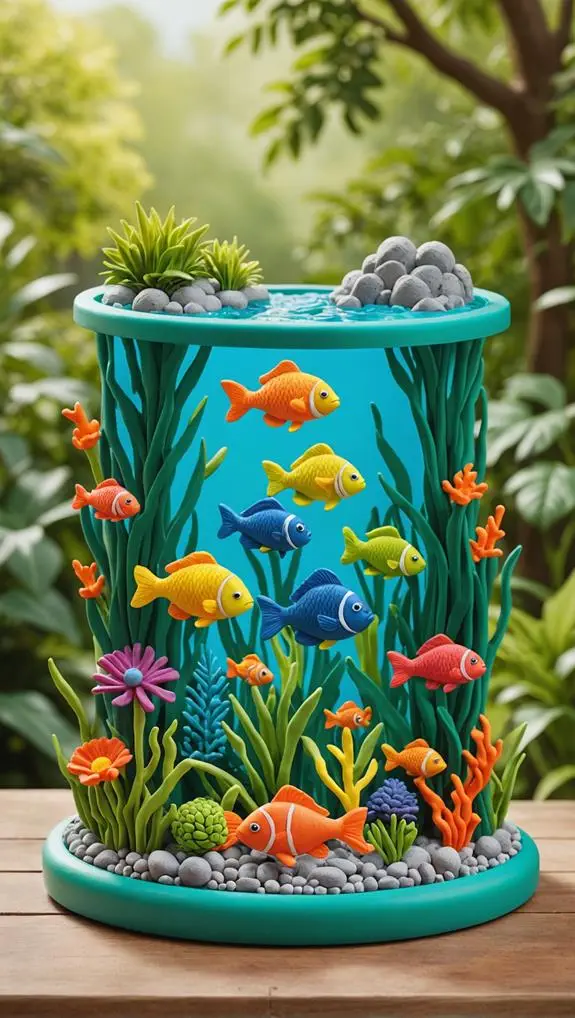
When it comes to keeping your fish happy and healthy, using a chiller can be a game changer. It not only keeps the water temperature steady, which is vital for sensitive species, but it also reduces the stress your fish experience from temperature swings—kind of like giving them a nice, cool spa day!
Plus, you'll save on energy costs and maintenance, so you can spend more time enjoying your aquatic friends instead of worrying about their comfort.
Consistent Temperature Regulation
Stability in water temperature is essential for maintaining a healthy aquatic environment, and using a chiller offers significant advantages in achieving this consistency. When you invest in a chiller, you can keep your aquarium's temperature just right for your beloved fish.
Here's why consistent temperature regulation matters:
- It helps tropical fish thrive, as they prefer warm waters in the mid to upper 80s °F.
- You can cool down aquarium water effectively, preventing stress during those sweltering summer days.
- It reduces the need for constant water changes, giving you more time to enjoy your underwater friends.
Chillers work by circulating and cooling the water before it returns to the tank, efficiently removing heat generated by ambient conditions.
This is especially crucial during heatwaves when temperatures can spike. Plus, you can set precise temperature levels based on your fish species' needs, creating a stable environment that promotes health and happiness.
Reduced Fish Stress
Reducing fish stress is crucial for fostering a vibrant aquarium, and using a chiller plays a key role in achieving this goal. When water temperature rises, it can cause serious issues for your fish. Warmer water holds less dissolved oxygen, leading to increased fish stress and health problems.
By investing in a chiller, you can keep your aquarium cool and maintain stable temperatures that help prevent rapid fluctuations. Chillers not only keep your fish comfy, but they also support optimal metabolic rates, enhancing their overall health.
When fish aren't stressed from overheating, their immune systems stay strong, which means they're less likely to get sick. Plus, a cooler environment means less algae growth. Who wants a tank that looks like a swamp, right?
Water Change Best Practices
To effectively manage the temperature in your aquarium during the summer months, implementing proper water change techniques is essential. You can help your fish thrive by sticking to a few water change best practices. Here are some tips to get you started:
- Perform small partial water changes (10-20%) with cool water.
- Make sure the replacement water is dechlorinated and matches your tank's pH and hardness.
- Monitor the tank's temperature before and after each change.
Using cool water that's at least 5-10°F cooler than your tank will help gradually lower the overall water temperature. This approach prevents shocking your fish, which is key for their health.
Regular partial water changes not only help with cooling but also dilute harmful toxins like ammonia and nitrites that can build up during those scorching heat waves.
Don't forget to keep an eye on the temperature shifts as you change the water. It's all about creating a safe, comfortable environment for your aquatic friends.
Monitoring Temperature Consistently
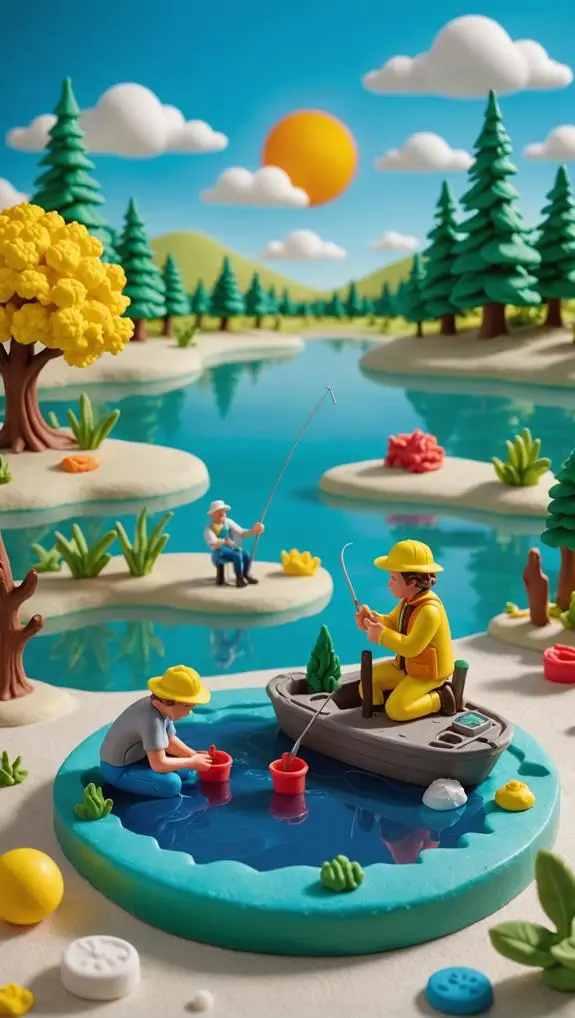
Keeping your aquarium's temperature in check is just as important as performing regular water changes. You wouldn't want your fish to feel like they're in a sauna! Consistent monitoring is key to ensuring their comfort and health.
Use a reliable thermometer or digital monitor to keep track of the temperature, aiming for that sweet spot of 74°F to 80°F, which most tropical fish love.
Don't forget to check your filtration system too. If it's not working efficiently, it can lead to toxic spikes in ammonia and nitrites, which can mess with your water temperature and your fish's well-being.
Consider setting up an alarm system that alerts you when temperatures go too high. It's like having a mini lifeguard for your tank!
Documenting temperature changes throughout the day can help you spot patterns. If you notice a pattern in evaporation or fluctuations, you can adjust your cooling strategies smoothly.
Remember, gradual changes are best. Sudden shifts can stress your fish out, and we definitely don't want that!
Additional Cooling Tips and Resources
When summer heat cranks up, you've got several effective cooling strategies at your fingertips to keep your aquarium thriving.
Here are some handy tips to help keep your aquatic friends comfortable:
- Use fans: Placing a fan over the aquarium surface boosts evaporation in an aquarium and helps cool things down, especially in low-humidity areas.
- Wet paper towels: Drape damp paper towels around the tank. As water evaporates, it cools the air, making a noticeable difference.
- Insulating tank surfaces: Materials like Styrofoam can be your best friend when it comes to keeping heat out.
Regular partial water changes with cooler, treated water can also provide a refreshing dip for your fish during those heatwaves.
And if you're really serious about keeping things chill, consider investing in a chiller. They efficiently maintain stable water temperatures, ensuring your aquatic pals stay happy and healthy.
Frequently Asked Questions
How Do You Keep Fish Cool in the Summer?
To keep your fish cool in summer, monitor fish temperature closely. Use cooling methods like fans and partial water changes to reduce summer stress, while maintaining oxygen levels. Adjust feeding habits to prevent excess waste.
How to Cool a Fish Tank Down in Summer?
To cool your tank, try temperature monitoring, fan circulation, and shade placement. Implement tank insulation to slow heat absorption and encourage water evaporation. These steps ensure a serene summer for your aquatic friends.
How Do You Fish in Hot Summer?
To fish in hot summer, focus on early morning fishing and evening bite techniques. Use the best summer baits, explore shallow water strategies, and prioritize hydration for anglers to ensure a successful and enjoyable experience.
How to Cool an Aquarium Without a Chiller?
Picture ice packs gently resting against your tank, while strategically placed fans create a refreshing breeze. Shade the tank, perform cool water changes, and let live plants thrive, ensuring your aquarium remains a serene haven for your fish.
Final Thoughts
So, you see, keeping your fish cool during those hot summer days doesn't have to feel overwhelming. By using techniques like evaporative cooling or relocating your aquarium, you can create a comfy environment for your aquatic friends. Sure, it might seem like a lot of work, but think of it as a fun summer project! After all, happy fish make for a happy you, and who doesn't want their underwater buddies to thrive? Keep swimming towards cooler waters!


